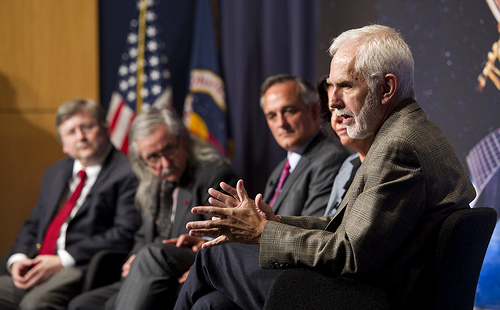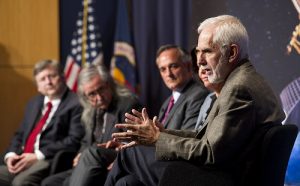Date Posted: June 17, 2011
Print Edition: June 10, 2011
By Jason Ho (Science Whiz) – Email
For your everyday situations, such as describing how a ball falls, or how fast a cart will roll down a hill, Newton’s theory of gravity is quite adequate. Even much of the early investigation of our solar system was done from a Newtonian perspective. However, Newton’s view of gravity was not complete.
The first clue to this came in the late 1800s, when astronomers noticed that the orbit of Mercury wasn’t quite what Newton’s theory predicted. There is a slight wobble to it, technically referred to as the “perihelion shift of Mercury.” Many years after Newton’s theories were proposed, Albert Einstein published his papers on the Special Theory of Relativity, which said that information could not travel faster than the speed of light. Newton’s theory of gravity did not take this into account; in fact, the equation which Newton came up with to describe gravity works instantaneously, which violates Einstein’s theory of a “universal speed limit.” So, Einstein went about revising how the world understood gravity.
What Einstein came up with was truly bizarre. He proposed that gravity wasn’t even a force, but a distortion of a four-dimensional “spacetime,” which was a construction that combined normal three-dimensional space with a fourth time dimension. Any object that has mass distorts the spacetime around it. A two-dimensional visualization would be of a bowling ball resting in the middle of a stretched rubber sheet. Gravity wasn’t a force, but a result of how surrounding spacetime was stretched. This was Einstein’s theory of General Relativity.
As hard as it may be to picture, General Relativity works amazingly well. It accurately predicts the perihelion shift of Mercury, and both General and Special Relativity are vital to the accuracy of the clocks on the Global Positioning System (GPS) satellites.
Forty years after Einstein published his ideas in The Foundation of the General Theory of Relativity, two scientists, Leonard Schiff and William Fairbank, proposed an experiment to NASA that would determine two predictions of Einstein’s theory caused by the mass and rotation of the Earth. Imagine a spinning top on a flat, perfect surface, such that the top never wobbles or falls. The axis of the top will always point in the same direction. If we place that same top out in space, assuming a distorted spacetime, the top will change its orientation. This is what is referred to as geodetic precession. The other effect is caused by the rotation of the Earth in the distorted spacetime. It was predicted in 1918 by Hans Thirring and Josef Lense that rotations of massive objects would cause further distortions in spacetime which would affect how the orbits of nearby objects would behave. This is a phenomenon called “frame-dragging.” It was predicted that these effects could be measured by launching satellites equipped with gyroscopes into orbit around the Earth. The problem was that the technology needed for the experiment that they proposed was extremely precise; there were doubts that the experiment was even possible at the time. Nevertheless, funding was obtained in 1963, and the project that was to become “Gravity Probe B” was started.
Fast forward to a press conference at NASA on May 4, 2011, reported on by Dr. Tony Phillips, where the results of the experiment that had been started more than 40 years before were announced. Along the way, 13 new technologies were invented specifically for the project, including incredibly precise spheres used as gyroscopes on the satellite. At any one point, they don’t differ from a perfect sphere by more than 40 atomic layers. Also, in order to measure the frame-dragging phenomenon, an instrument with a precision akin to “measuring the thickness of a sheet of paper held edge on 100 miles away” was developed. It took years of planning, as well as hundreds of scientists, but the satellite, dubbed “Gravity Probe B,” measured the same effects that Einstein predicted, adding to the credibility of Einstein’s bizarre theory.



